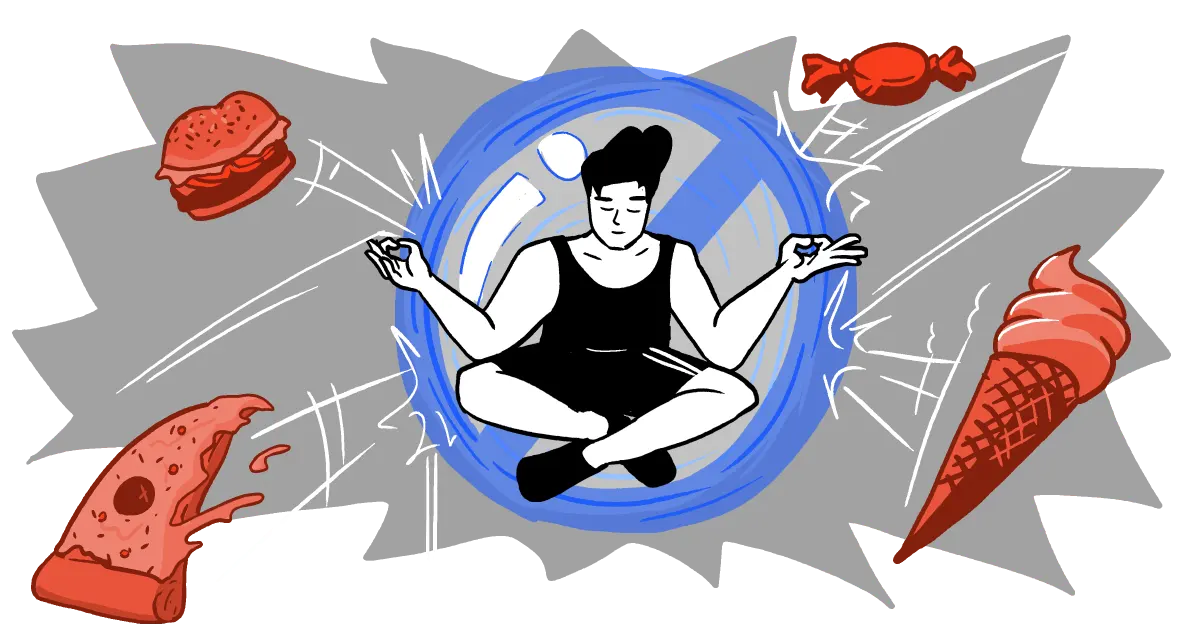
Discovering methods to divert your attention from hunger can significantly alleviate hunger pangs and assist in adhering to a diet. Yes, it may be annoying but at least there’s something you can do about it!
Show that growling stomach who’s boss by following these 5 easy solutions proven to get your mind off that hungry sensation.
1. Do Something Mindless to Distract Yourself
Engaging in mindless activities can sometimes be the quickest and easiest way to distract yourself from hunger. If you have something that needs to be done around the house, start cleaning, washing dishes, mopping the floors, sweeping, dusting the shelves, vacuuming the carpet, or folding laundry.
Not only will you be doing something physical that can ‘distract’ your body from hunger, but you can occupy your mind with the detailed aspects daily chores or even self-care.
Taking a bath or other beauty related tasks can also help you mentally and physically de-stress, which can help avoid weight gain all together.1 Other ways you can stop hunger pangs is to find a healthy distraction like journaling to reflect or write our goals.
2. Engage in a Mentally Demanding Task
On the flipside, choosing a mentally demanding or engaging task will not only help keep your mind off of constant hunger pangs and thoughts of food, but it is beneficial for your brain and psychology. So rather than being preoccupied with food the entire day, figure out how to distract yourself through productivity.
Some productive ways to mentally sidetrack yourself is to solve a puzzle, play a video game, a board game, or journaling as a healthy coping mechanism. Keep in mind, exercising may not be the best distraction for hunger pangs because it will likely increase your metabolism, burn food currently in your stomach, and make you hungrier.
If you are interested in doing something physical — whether due to personal enjoyment or to increase your daily activity level — taking a walk may be your best option.
3. Distract Yourself by Eating Something Low in Calories
While technically not a distraction and it may seem like caving in, sometimes the act of eating alone is enough to satiate us. Choosing healthy and low-calorie alternatives for snacks can help you cut down on calorie dense foods, overeating at meals, and excess snacking on sugary or fatty options.
Finding low-calorie options to snack on between meals can help you reduce total calorie intake and curb hunger. You can eat quite a bit of butter-less popcorn or berries without exceeding 100-200 calories. Try making a healthy fruit and vegetable juice to get whole foods, plenty of nutrients, and ample fiber to keep you full between lunch and dinner.
You may also consider eating that low calorie snack slowly since it can help overall mindfulness.2
Improving your eating habits can be easier than you think. Begin with drinking water, chewing gum, making smart substitutions, and snacking on healthy food.
4. Drink an Abundance of Water

Drinking an abundance of water can help you feel full and reduce hunger since oftentimes our minds mistake ‘thirst’ signals for hunger pangs. Just because we WANT to satisfy our mental craving for food, it doesn’t mean our body actually needs it. So next time your stomach growls, try drinking 12-32 oz of water to see if that makes a difference.
If you’re a weight-based athlete gearing up for a competition, the only time you might need to manage or limit your water consumption is before the event. In such cases, it’s essential to refer to the step-by-step guide on powerlifting water cutting for safe practices.
5. Chew Gum
The physical motion of chewing can help sidetrack those hunger pangs and gum is a great 0 calorie solution. Chewing anything might help, but people should avoid xylitol or sugary gum that can lead to potential negative side effects. Even though xylitol does not spike blood sugar levels nearly as much as regular sugar, it can still increase blood sugar levels to some extent and that might leave you feeling hungrier than before.
Forget Distractions – Curb Hunger From The Start
Knowing techniques to divert your attention from hunger can be good for short-term cravings. But long-term solutions can allow you to address hunger from the start, rather than trying to distract yourself later on. So instead of finding distractions, it’s important to find solutions that leave you feeling full.
Eat More or Less Frequently
The influence of meal frequency and timing on health in humans is absolutely crucial no matter the goal.3 Spacing out meals can be good for some people and keep blood sugar more consistent, which can lessen cravings. Instead of eating one big meal a day for lunch, consider eating smaller meals, more often. Some people may enjoy the feeling of eating more often to help with the mental need to enjoy flavors and chew foods.
In contrast, some people prefer to fast the entire day and eat one big meal — otherwise known as OMAD. Intermittent fasting is another popular option too. Intermittent fasting can lead to improvements in certain health conditions and shows health benefits in those with cardiological conditions, obesity, or diabetes.4
So rather than always finding new methods to distract yourself from hunger, experiment to see if eating frequency helps. Or, get rid of hunger pangs when fasting by eating enough macronutrients during your ‘eating window’.
Get Enough Fiber & Protein
Both fiber and protein are must-have nutrients that help you feel full, for longer. Dietary fiber modulates food ingestion, digestion, absorption, and metabolism.5 Optimizing fiber within diets improves both metabolic and overall health.6
Protein is another important nutrient that helps us stay full, builds muscle, and regulates our body. Protein is more satiating than other macronutrients, helping people with appetite-related implications.7 If you’re aiming to boost your protein intake, consider incorporating liquid smoothies and shakes into your routine. But remember to conduct thorough research beforehand to assess whether protein shake and diet plans align with your long-term goals or represent just another fleeting trend.
Eat Wholesome Meals
Eating processed foods that lack wholesome ingredients leads to ingesting empty calories — which fails at satisfying hunger cravings. Everyone should strive to eat a nutritious and balanced diet, complete with whole foods that contain vitamins, minerals, fiber, and antioxidants.8 Of course, this is easier said than done but even some fruits and veggies on occasion is a good start.
Take, for example, plain oats vs. prepackaged oatmeal cups loaded with sugar, or ice cream vs. fruit. One is naturally better for long-term health and feels full for longer.
In addition, if you are focused on aesthetics and optimal performance, diet is key — especially if you are an athlete. Athletes with the goal of gaining muscle mass and reducing body fat may discover that a powerlifting or powerbuilding diet offers the most suitable approach.
Figuring out how to divert your attention from hunger is essential to making healthy food choices, avoiding overthinking, and stopping hunger pangs in their tracks.
Doing mindless tasks to get your mind off hunger, finding new hobbies, and engaging in mentally demanding activities can be the mental bridge between overthinking about food. In addition, eating low-calorie foods, chewing gum, and drinking water can help individuals avoid mindless snacking, empty calories, and hunger pangs.
References
1Why stress causes people to overeat. (2021). Harvard Health Publishing. Retrieved from <https://www.health.harvard.edu/staying-healthy/why-stress-causes-people-to-overeat>
2Davis, Tchiki. How to Eat Mindfully by Listening to Your Body. (2019). Greater Good Magazine. Retrieved from <https://greatergood.berkeley.edu/article/item/how_to_eat_mindfully_by_listening_to_your_body>
3Paoli, A., Tinsley, G., Bianco, A., & Moro, T. (2019). The Influence of Meal Frequency and Timing on Health in Humans: The Role of Fasting. Nutrients, 11(4), 719. <https://doi.org/10.3390/nu11040719>
4Research on intermittent fasting shows health benefits. (2020). National Institute on Aging. Retrieved from <https://www.nia.nih.gov/news/research-intermittent-fasting-shows-health-benefits>
5Kaczmarczyk, M. M., Miller, M. J., & Freund, G. G. (2012). The health benefits of dietary fiber: beyond the usual suspects of type 2 diabetes mellitus, cardiovascular disease and colon cancer. Metabolism: clinical and experimental, 61(8), 1058–1066. <https://doi.org/10.1016/j.metabol.2012.01.017>
6Barber, T. M., Kabisch, S., Pfeiffer, A., & Weickert, M. O. (2020). The Health Benefits of Dietary Fiber. Nutrients, 12(10), 3209. <https://doi.org/10.3390/nu12103209>
7Lonnie, M., Hooker, E., Brunstrom, J. M., Corfe, B. M., Green, M. A., Watson, A. W., Williams, E. A., Stevenson, E. J., Penson, S., & Johnstone, A. M. (2018). Protein for Life: Review of Optimal Protein Intake, Sustainable Dietary Sources and the Effect on Appetite in Aging Adults. Nutrients, 10(3), 360. <https://doi.org/10.3390/nu10030360>
8The Health Benefits of Whole Foods. Penn State University. Retrieved from <https://sites.psu.edu/myhealthylife/2019/06/13/267/>